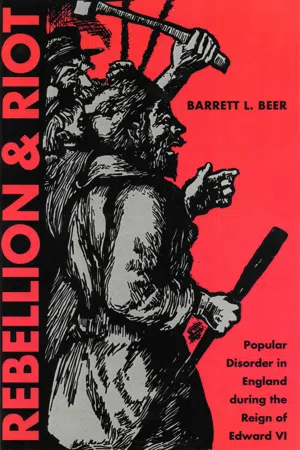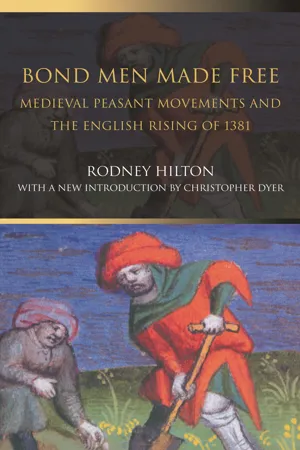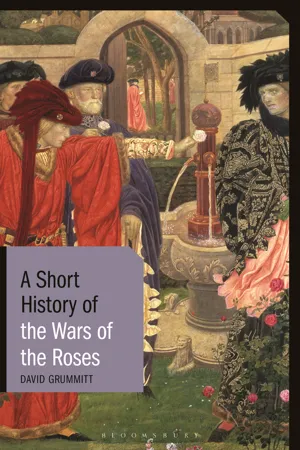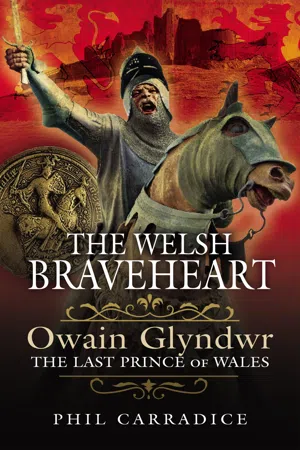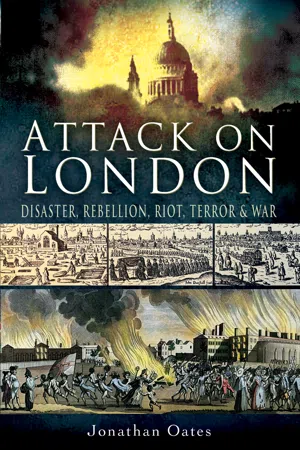History
Yorkshire Rebellion
The Yorkshire Rebellion was a popular uprising in northern England in 1489, triggered by high taxes and economic grievances. Led by Sir John Egremont and Thomas, Lord Darcy, the rebellion aimed to challenge the authority of King Henry VII. Despite initial successes, the rebellion was eventually suppressed by royal forces, leading to the execution of its leaders and the imposition of harsh penalties on the rebels.
Written by Perlego with AI-assistance
Related key terms
Related key terms
1 of 4
Related key terms
1 of 3
6 Key excerpts on "Yorkshire Rebellion"
- eBook - ePub
Rebellion and Riot
Popular Disorder in England During the Reign of Edward VI
- John A. Andrew, III(Authors)
- 2000(Publication Date)
- The Kent State University Press(Publisher)
4Rebellion played a smaller role during the reign of Elizabeth, but even Gloriana felt the sting of revolt in 1569 when the earls of Northumberland and Westmorland restored the Latin mass at Durham Cathedral, called for the arrest of Sir William Cecil, the queen’s leading adviser, and demanded the restoration of Roman Catholicism. Less threatening than the mid-Tudor rebellions, the rising of the northern earls revealed the deep-rooted discontent of the aristocracy and its tenants. The last rising of the Tudor era took place in 1601, only two years before the death of Elizabeth, when the Earl of Essex, frustrated by his loss of royal favor, led 200 supporters up Fleet Street, London, in a desperate and futile attempt to restore his political ascendancy.5 A survey of Tudor rebellions leads to the inescapable conclusion that every rebel captain whether artisan or earl and every popular cause — religious, political, or economic — suffered defeat. What is remarkable and usually overlooked by historians is the courage of generations of Tudor rebels to resist oppression and go down to defeat in the face of overwhelming odds.Although popular disorder was endemic throughout the sixteenth century, the pattern of rebellion and riot was extremely diverse. The rebellion of Henry Tudor in 1485 began as a royalist conspiracy against the Yorkists, and the dynastic interests of the Courtenays and Mary Stuart played important roles in later risings. When political opposition to the Tudors was not dynastic, it usually included conflict between court and country. For example, the northern aristocracy in 1536 and 1569 and the western gentry in 1549 vigorously opposed policies emanating from the court. The leadership of Thomas Cromwell and William Cecil aroused regional discontent; remote counties feared centralizing reforms of all kinds; and in 1549 the western gentry saw the Edwardian Reformation as little more than the program of court politicians supported by a clique of heretical clergy. After Henry VIII’s break with Rome in the 1530s, religion emerged as a divisive issue that fired political and social instability. Only under Edward VI did Catholics and Protestants rise at the same time. Religious unrest during the reigns of Henry VIII and Elizabeth came primarily from Catholics opposed to the royal supremacy, the monastic dissolution, and innovations in the church, while Mary’s opponents were exclusively Protestant. Real or imagined social and economic grievances played a part in many rebellions, particularly the Cornish Rebellion of 1497, the Pilgrimage of Grace, and Kett’s Rebellion in Norfolk. Riots almost always stemmed from economic issues; frequently heard grievances concerned rent payments, food prices, enclosure, and property rights. - No longer available |Learn more
Bond Men Made Free
Medieval Peasant Movements and the English Rising of 1381
- Rodney Hilton(Author)
- 2004(Publication Date)
- Routledge(Publisher)
But, whether reactionary or progressive, they were all-class movements of peasants, yeomen, artisans and merchants under their natural leaders, the local gentry. There is quite a strong case for interpreting in this sense the rising of 1450, usually associated with the name of Jack Cade, as well as the various provincial risings in the first half of the sixteenth century. Is it justifiable, however, to extend this interpretation to the events of 1381? 13 13 M. E. James, ‘Obedience and dissent in Henrician England: the Lincolnshire rebellion of 1536'. P & P, 1970, p 8; B. Wilkinson, Constitutional History of England in the 15th Century, 1964, p 37; Dobson, p 380. There is more than one way of approaching this problem. We may again look at the social composition of the rebel bands. There is no question here of provincial society under the ‘natural' leadership of the gentry, in spite of the occasional participation of discontented landowners in East Anglia such as Sir Roger Bacon, who in any case played second fiddle to the dyer, Geoffrey Litster. As we have seen, the composition of the rebel armies seems to have been a fair cross-section of rural society, but, apart from a few exceptions, below the ranks of the nobility, the gentry, the lawyers and the beneficed ecclesiastics. Insofar as we can use medieval social categories, it was a broadly-based popular uprising of the third estate (but excluding the London merchant capitalists) against the other two components of the tripartite society of the middle ages, not a movement of all social groups against a narrow governing clique. There is not the slightest sign of even the beginnings of an alliance between the rebels and any group which had a part to play in the accepted political game: in other words, no friends, no apologists even, either in Parliament or in the Convocations of clergy - Michael Hicks(Author)
- 2003(Publication Date)
- Routledge(Publisher)
coups d’état by great magnates, such as York’s Dartford (1452) and St Albans (1455) campaigns, sought to change the personnel of the government and/or its policies. Force was applied unexpectedly against a regime too powerful to engage in open conflict. No effective resistance was possible when York ambushed the court in 1455 or for Gloucester’s seizure of Edward V in 1483. Fifthly, the largest and most formidable rebellions, those that threatened to overthrow not merely councillors, but king and dynasty, combined features of all others. Such attacks had to overcome the allegiance owed by all subjects to the crown, the presumption in its favour and its consequent massive advantage in resources. Surprisingly many uprisings achieved their objectives in the fifteenth century. Most failed. Rebellion was a high-risk strategy to be attempted only as a last desperate fling.Rebellions were never irrational. Participants decided to rebel. Rebellions always had causes. Whenever historians investigate rebellions, they invariably uncover grievances and frictions in the preceding years. Harvey tracked Cade’s Rebellion back to causes twelve years old; Henry VII’s Yorkshire and Cornish uprisings, like the Peasants’ Revolt itself, were precipitated by national taxation. Albeit false, fears of afforestation in 1450 and of a judicial eyre in 1470 were incentives to rebel. Such problems were known to the authorities, so action could be taken to remedy grievances, dispel misapprehensions or to suppress protests before they expanded into insurrection. Such causes did not make conflict inevitable. Disputes about land, labour and taxation occurred at all times and in all areas. Special combinations of circumstances caused them to outgrow their origins and develop into something else.- eBook - ePub
- David Grummitt(Author)
- 2014(Publication Date)
- I.B. Tauris(Publisher)
In the event the jousts at Smithfield were cut short by the death of Philip the Good on 15 June 1467. This was the opportunity Edward had waited for in order to press ahead with his diplomatic encirclement of France. Alliances were cemented with Brittany and Castille and in November the king sealed a trade treaty with Burgundy. At the same time Edward’s sister, Margaret, appeared before the council and agreed to marry Charles, the new Duke of Burgundy. This was duly ratified in February 1468 and in May the king announced to parliament his intention to invade France. The response was positive in the form of a substantial grant of taxation, but the king’s policy was a risky one. He had made unpopular trade concessions to the Burgundians, borrowed heavily to pay his sister’s dowry, and alienated his most powerful subject, the Earl of Warwick. By the end of 1468 Edward’s policies at both home and abroad were beginning to destabilise the realm. Rumours of Lancastrian plots abounded: a major conspiracy involving the London alderman, Sir Thomas Cook, and several reconciled Lancastrians, such as Sir Gervase Clifton, was uncovered. More sinisterly, committed Yorkists and servants of the Earl of Warwick, like John, Lord Wenlock, were also implicated. Rumours spread on the continent that Warwick was in secret negotiations with the Lancastrians in exile or that he planned to place the king’s younger brother, the Duke of Clarence, on the throne. These rumours Earl Richard refused to even grace with an answer when summoned to appear before the king. Local unrest broke out in Kent and in the midlands in 1468 and elsewhere disquiet arose over the influence of some of Edward’s favoured courtiers. Early in 1469 Thomas Hungerford and Henry Courtenay were arrested in the south-west and subsequently executed, principally, it was rumoured, because Humphrey, Lord Stafford of Southwick, coveted the Courtenay earldom of Devon. The rumours appear to have been proved true in May when Stafford was created Earl of Devon.REBELLION AND DEPOSITIONBy the beginning of 1469 Edward IV’s authority was seriously compromised. He had reneged on his promise to invade France (but kept the taxation granted for this purpose) and grasping courtiers were dominating the king’s counsel and royal patronage, while powerful magnates of the king’s own blood were excluded from their rightful position in the realm. If this litany of royal wrongdoing had a familiar ring to it, it was precisely because the king’s opponents, principally the Earl of Warwick, decided to portray Edward’s regime in this way, reviving the ‘commonweal’ language used by the Yorkist lords in 1459–61. Warwick decided to make his move in June. In April there had been a popular uprising in Yorkshire, led by one Robin of Redesdale. The rebels’ grievances were the familiar ones (taxation, evil counsellors, and local misgovernment), but there is nothing to suggest that Warwick was involved. Indeed, his brother, the Earl of Northumberland, appears to have suppressed it without difficulty. However, as soon as this rebellion was suppressed the county rose again, this time led by one Robin of Holderness. The principal grievance this time was local clerical taxation, but the rebels also demanded the restoration of the Percy family to the earldom of Northumberland. Later Tudor chroniclers identified Warwick’s hand behind these events but this seems unlikely and before long John Neville had crushed that rising too.A third rising in June, however, was far more serious and seems certain to have been engineered by Warwick. It is unclear whether the earl had planned this rising in advance or, like the Duke of York before him, he had merely taken advantage of his own popularity among the commons and appropriated their grievances and political platform to his own ends. The rebel leader again called himself Robin of Redesdale, but on this occasion he appears to have been a member of the Conyers family, long-standing Neville servants. The head of the family, Sir John, was Warwick’s steward in Richmondshire and the rebellion in effect mobilised the Nevilles’ Middleham affinity against the king. At the same time Warwick put the second part of his plan into action. On 6 July he crossed to Calais in the company of Archbishop Neville, his daughter Isabel, and the king’s brother, George, Duke of Clarence. There, on 11 July, he married his daughter to Clarence against the king’s express wishes, and on the following day the rebel lords issued a manifesto ‘for the honoure and profite of oure seid sovereyn Lord and the comune welle of alle this his realme.’8 - eBook - ePub
The Welsh Braveheart
Owain Glydwr, The Last Prince of Wales
- Phil Carradice(Author)
- 2022(Publication Date)
- Pen and Sword History(Publisher)
Chapter FourRebellion
The Welsh rebellion – Owain Glyndwr’s war – cannot be looked at in isolation. It was part of a wider conflict, one that involved the deposing and killing of a king and the establishment of a usurper on the throne of England. It took place at a time when murder and mayhem were, if not daily occurrences then certainly regular events. It was a time when armies marched across the land, burning and pillaging as they went. In its brutality the era foreshadowed only too clearly the destruction of the later Wars of the Roses.The tyranny of Richard II was short lived, barely two years, but it saw a seismic change in the upper echelons of English society. The arrest and execution of the Duke of Gloucester and the Earl of Arundel in 1397 had clearly unblocked some sort of dam in Richard’s head, causing him to lose whatever little self-control he had possessed.He had come to the throne early and had been fêted and lauded all through his childhood and adolescence. There was no doubt that he was brave, his performance during the Peasants’ Revolt had shown that, but Richard was sadly lacking in judgement. As an absolute ruler he had no reason to be self-critical or to question either his ability or his actions. Whatever he did was right, it had to be – after all, he was the king.Now, following the success of his coup against Arundel and Gloucester, Richard felt all-powerful. When, in 1398, his position was made even more comfortable by the sudden death of another ‘enemy’, Roger Mortimer, the Earl of March, his emotions began to surge and propel him forwards.Suddenly the king’s natural desire for dictatorial rule burst into the open. Unlike most mediaeval monarchs, Richard had very little in the way of guidance or assistance from older, wiser nobles. He was alone and made his mistakes alone.One of the first things he did was to remember his antipathy towards the Duchy of Lancaster and banish his cousin Henry Bolingbroke, the son of John of Gaunt. The popular and powerful Bolingbroke, Henry of Lancaster to give him his correct title, was perceived as a major threat and exile seemed an appropriate way to deal with this potential opponent. It was mistake number one – Richard would have done better to kill him. - eBook - ePub
Attack on London
Disaster, Rebellion, Riot, Terror & War
- Jonathan Oates(Author)
- 2009(Publication Date)
- Pen & Sword(Publisher)
Londoners had been divided in their allegiances in 1450. Some shared the rebels’ grievances and joined them, at least temporarily. The authorities, once the King left, were in a quandary: they were instinctively opposed to the rebellion but unsure how to deal with the threat. Once violence erupted in the streets in a drunken orgy, they were able to rally the populace and, under military guidance, defeat the rebels in open battle.Sir Thomas Wyatt’s Rising 1554
The sixteenth century was no less a time of turmoil than previous epochs. The religious policies pursued by Henry VIII and his son Edward VI were divisive, creating numerous factions of Protestants and Catholics. When the latter died in 1553 there was a contest for the throne, with the late King’s chief adviser, the Duke of Northumberland, attempting to make his new daughter-in-law, Lady Jane Grey, Queen, instead of Henry VIII’s eldest daughter, Mary. Yet he had little support and to the delight of Londoners, the Catholic Mary was crowned Queen in 1553. She was seen as the rightful successor following the death of her childless brother. But she courted unpopularity the following January by announcing her intention of marrying Philip II of Spain, the predominant Catholic ruler in Europe. Public annoyance was initially limited to pelting Philip’s envoys with snowballs but quickly escalated into a full-blown insurrection of Kentish men, led by Sir Thomas Wyatt.Wyatt began with only 3,000 followers — many members of the county gentry opting to stay neutral — and his chances looked slim. The government acted swiftly, ordering the Duke of Norfolk to lead the City of London’s Trained Bands against Wyatt at Rochester. These citizen soldiers were among the capital’s best troops, for though they were only part-time soldiers, they at least possessed proper weapons and some rudimentary training. However, the men of the Trained Bands, perhaps by a pre-arranged signal, declared their allegiance for Wyatt, shouting ‘We are all Englishmen!’ One of their captains advocated an immediate march on London, declaring: ‘For London, they said longed sore for their coming, which they would by no means protract without breeding great peril and weakness to themselves.’ When the remnant of the force retuned to London, the sight ‘was almost no less joyous to the Londoners.’6
Index pages curate the most relevant extracts from our library of academic textbooks. They’ve been created using an in-house natural language model (NLM), each adding context and meaning to key research topics.
Explore more topic indexes
Explore more topic indexes
1 of 6
Explore more topic indexes
1 of 4
